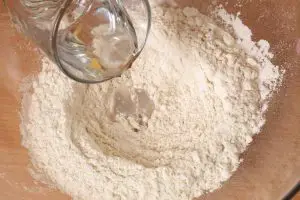Ascorbic acid is known by many people as vitamin C. There are many known benefits for people who take vitamin C, but they want to know if it has the same benefits when it is used in baking bread. Ascorbic acid is often used by commercial businesses in bread making.
While vitamin C is good for you, ascorbic acid in large quantities can actually be harmful. It can cause headaches, fainting, nausea, and skin irritation. However, the ascorbic acid in bread is such a small amount it doesn’t have any of these effects and won’t harm you. Take a look at why ascorbic acid is used in bread baking and when you might choose to use it.
Why Is Ascorbic Acid Used in Bread?
Ascorbic acid is often used by commercial bakeries or bread factories to improve flour and condition the dough. This speeds up the dough rising and helps to extend the shelf life of the bread. Rather than being used as an antioxidant, it is used as an oxidizer. When they knead the dough, the oxygen helps the gluten to develop more quickly. The ascorbic acid makes the dough more elastic and stable, and it is better able to expand without rupturing while it bakes.
When you make homemade bread, you don’t normally need to use ascorbic acid. Most of the time, people bake a loaf and it is eaten in a few days. The amount of ascorbic acid you would use for a small batch of bread is so small that it won’t really make a difference, and there is no reason to extend the shelf life.
However, if you plan to freeze your dough, you might want to use ascorbic acid. The yeast in your bread is a living organism, and about 30% of it dies when you freeze it. Dough is mostly flour and water, and when you freeze it, the liquids will dilate. The expansion of the water as it freezes will actually break the texture of your dough.
When you use ascorbic acid, it will help you revive the dough when it is time to thaw it. It actually helps to compensate for the fact that some of the yeast died off while it was frozen. If you plan to freeze the dough for a few months, you can use ascorbic acid and it will still be delicious and crispy when you thaw it and cook it later.
How Much Ascorbic Acid Should I Put in My Bread?
If you are using untreated flour that doesn’t have any ascorbic acid in it, you will use between 0.02 and 0.2 grams of ascorbic acid per kilogram of flour. You will need an accurate laboratory scale to measure this amount because it is such a small amount.
If you don’t have a lab scale, you can take vitamin C and dilute it in water. First, you need to know how much ascorbic acid you need. For example, for 0.1 grams of ascorbic acid that you are using with one kg of flour, you should take 10 grams of vitamin C powder and dissolve it in 100 grams of water. This makes a solution that is 10%. Then, for every one kilogram of flour, you need to add one gram of this solution. This will yield a concentration of 0.1% ascorbic acid.
What Can I Use in Place of Ascorbic Acid?
If you want to make bread with a bread improver, you can use other ingredients. A bread improver is usually a mixture of acids and enzymes that help to activate the gluten and feed the yeast, which helps with kneading, rising, and fermentation. The gluten gives dough its elastic properties, and when it ferments, it releases carbon dioxide, which is what allows the bread to rise.
You don’t need to use a bread improver when you are baking bread at home, but some people want to because they plan to freeze the dough, or they want bread with more flavor and texture. If you choose to use it, you may not have ascorbic acid or vitamin C, and you can substitute other ingredients.
You can use citric acid, vinegar, or orange juice as a substitute. Orange juice has vitamin C in it, and you can replace the water with orange juice if you want a lighter texture and rise. It will change the flavor as well. Citrus acid and vinegar will also add a tangy flavor to the bread, and some people always make their bread this way.
Final Words
Commercial bakeries and bread factories use ascorbic acid when they make bread because they need to speed up the activation of the gluten and make sure that the bread has a longer shelf life. While it isn’t necessary to use ascorbic acid when you bake bread at home, some people do. By the time the bread is made, you don’t really get the benefits of vitamin C, but there is nothing wrong with the small traces of ascorbic acid that are in bread.






